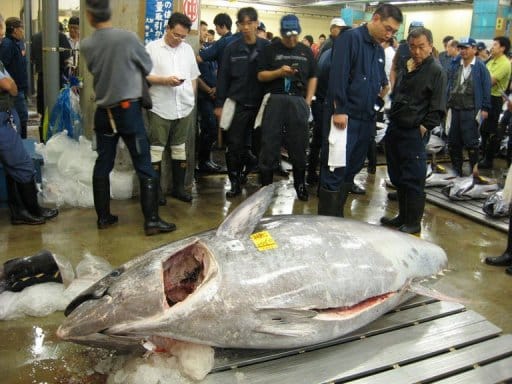The State of Bluefin Tuna

Bluefin tuna is highly prized, fetching prices in the tens of thousands of dollars for a single fish in famed yearly Japanese auctions. One such bluefin tuna sold for an incredible 1.76 million in 2013, a price which reflects the status and prestige of these animals.
The fact is, all three species of bluefin tuna are over-fished. Their populations have been decimated to compete with the huge demand that arose with the popularity of sushi worldwide.
A Brief History of Bluefin Tuna As Food (And Sushi)
How did it happen? Not so long ago, bluefin tuna was considered to be of such poor quality it was literally ground up and sold as cat food. Bluefin tuna has a long history of being considered unfit for human consumption, with the tuna being considered unclean throughout the ancient history of sushi in Japan.
Tuna populations remained robust and vital. Everything changed in the 1970s, when sushi started to hit the global market and rose to prominence. Suddenly, nobody could get enough of the fatty fish which had just years ago been considered garbage.
And while bluefin tuna grew in popularity worldwide, it is the sushi capital of the world, Japan, that consumes the bulk of the fish. Tuna stocks have plummeted, with pacific bluefin tuna seeing a more than 90% percent population decline from historic levels.
It is by no means hyperbolic to consider this a devastating blow to the future sustainability of this fish, unless drastic conservation measures are taken.
Making The Right Decisions In The Seafood Industry
A recent decision by the Northern Committee of the Western and Central Pacific Fisheries Commission (WCPFC) is a step in the right direction. The meeting, which was held in Fukuoka, Japan, was a week-long process in which the issue of tuna was the main talking point.
The plan is to cut the catch of juvenile tuna, or those that weigh less than 30 kilograms and have not yet reached reproductive age, in half. This is essential to the long term survival of the fish as it is the first step in reestablishing strong and sizeable breeding population of the species.
But cutting the catch of bluefin tuna is not as easy as it seems when the species it at risk of by-catch, an issue that is currently being address in other venues.
Many Organizations Are Involved To Maintain Seafood Sustainability
International bodies are not the only ones trying to stop the decline of bluefin tuna. The National Oceanic and Atmospheric Administration published a 750 page amendment to its managements plan in a effort to help the in danger fish. Bluefin tuna breed in the Gulf of Mexico, and are often killed as a by-catch when large trawling vessels use long-line fishing techniques.
In layman terms, long-lines are exactly what they sound like: 30 miles of hook loaded lines that have the precision of fishing with dynamite when you consider the impact to species such as bluefin tuna and swordfish.
The amendment, published in August 2014, includes such measures as requiring vessels to have cameras which track the impact of by-catch, improved monitoring systems, and the go ahead for industry funded observer programs and new gear restricted areas.
Can Bluefin Be Saved And Remain on Our Sushi Menu?
Bluefin tuna populations are under stress, but decisions at the international and national level are setting the groundwork for a recovery of the fish. The response to the record low levels of bluefin tuna is late but steps are being taken in the right direction for the recovery of the species as a whole.
Bluefin tuna stocks have faced significant pressure due to over-fishing, driven largely by their high value as a prized sushi item. However, recent conservation efforts and stricter fishing regulations have led to some signs of recovery in certain populations, particularly the Atlantic bluefin.
Despite these improvements, bluefin tuna remains vulnerable, and continued management is crucial to ensure sustainable fishing practices. The demand for bluefin in sushi remains strong, but there is a growing emphasis on responsible sourcing to protect the species for future generations.
Irasshaimase!
I have always been fascinated by the creation and culture of different foods, particularly sushi and sashimi in the modern era of Japanese cuisine. I am a classically trained chef and sushi connoisseur, also having operated a food service company and enjoy investigating and experimenting with food around the world.